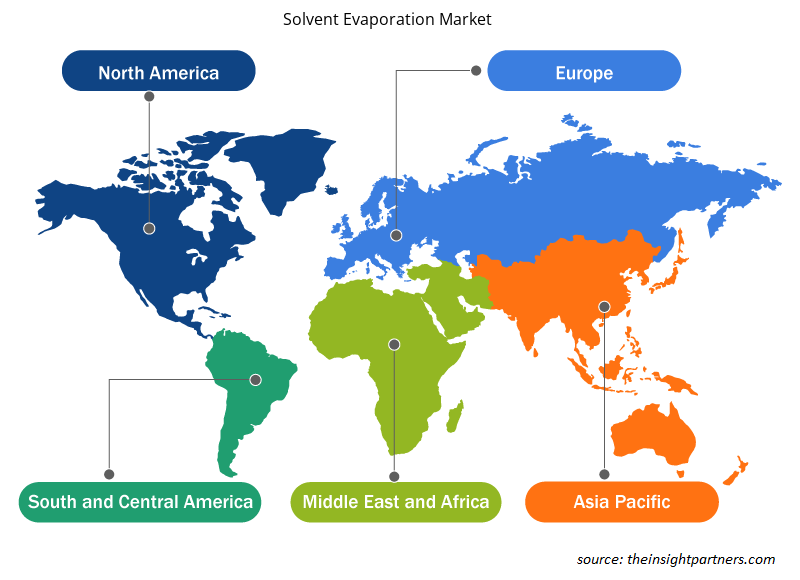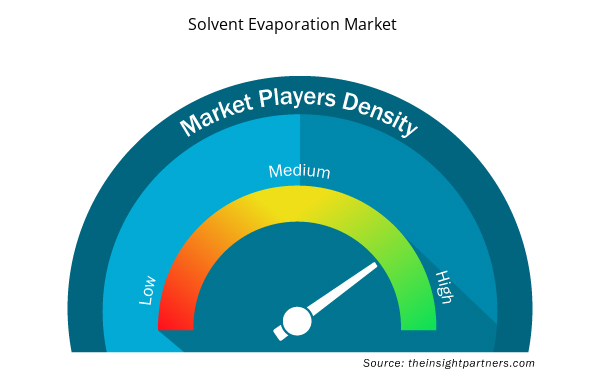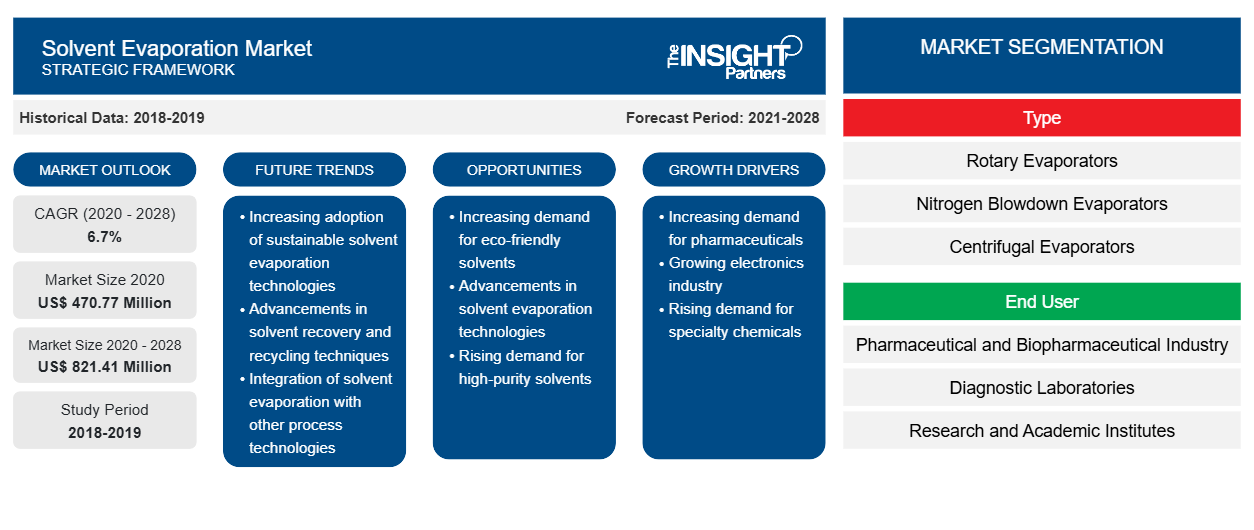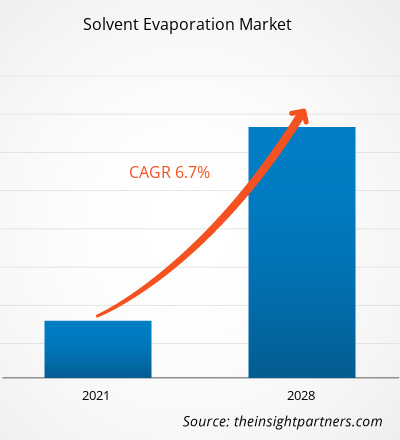Der Markt für Lösungsmittelverdampfung wurde im Jahr 2020 auf 470,77 Millionen US-Dollar geschätzt und soll bis 2028 821,41 Millionen US-Dollar erreichen; für den Zeitraum 2021–2028 wird ein durchschnittliches jährliches Wachstum von 6,7 % erwartet.
Bei der Lösungsmittelverdampfung wird ein Polymer in einer wässrigen Phase emulgiert und in einem flüchtigen Lösungsmittel wie Dichlormethan, Chloroform und Ethylacetat dispergiert. Anschließend wird das Lösungsmittel bei hohen Temperaturen, im Vakuum oder durch ständiges Rühren verdampft. Die Partikelgröße lässt sich durch Anpassen von Parametern wie Manipulation der Verdampfungstemperatur, Kontrolle der Verdampfungsrate, Manipulation der Rührgeschwindigkeit usw. steuern. Diese Methode wird für Nanopartikel angewendet, die unter Verwendung entsprechender Polymere wie PLA, PLGA, PCL, Polyhydroxybutyrat usw. entwickelt wurden und mit verschiedenen Medikamenten wie Tetanustoxoid, Testosteron, Loperamid, Cyclosporin A und Indomethacin beladen sind. Lösungsmittelverdampfer werden häufig in Prozessen wie der Mikroverkapselung eingesetzt und sind erforderlich, um polymere Nanopartikel für verschiedene pharmazeutische Formulierungen herzustellen. Technologische Fortschritte bei Lösungsmittelverdampfungssystemen, wie z. B. Zentrifugalkonzentration, Gefriertrocknung und Hochleistungskühlfallen, haben zu einer verstärkten Verdampfung und verbesserten Lösungsmittelrückgewinnung bei geringerer Umweltbelastung geführt.
Faktoren wie steigende Ausgaben für Forschung und Entwicklung, die zunehmende Entwicklung von Biopharmazeutika mit großen Molekülen und die steigende Nachfrage nach reinen Proben in Endverbrauchsmärkten treiben das Wachstum des Marktes für Lösungsmittelverdampfung voran. Ungenauigkeiten bei den Ergebnissen und Ressourcenverschwendung aufgrund von Unbehagen im Zusammenhang mit der Lösungsmittelverdampfung behindern jedoch das Wachstum des Marktes für Lösungsmittelverdampfung .
Passen Sie diesen Bericht Ihren Anforderungen an
Sie erhalten kostenlos individuelle Anpassungen an jedem Bericht, einschließlich Teilen dieses Berichts oder einer Analyse auf Länderebene, eines Excel-Datenpakets sowie tolle Angebote und Rabatte für Start-ups und Universitäten.
- Holen Sie sich die wichtigsten Markttrends aus diesem Bericht.Dieses KOSTENLOSE Beispiel umfasst eine Datenanalyse von Markttrends bis hin zu Schätzungen und Prognosen.
Markteinblicke
Steigende F&E-Ausgaben in der Pharmaindustrie
Die Lösungsmittelverdampfung aktiver Substanzen ist ein wesentlicher Schritt im Arzneimittelentdeckungsprozess, da sie in Phasen wie Synthese, Probenvorbereitung und Lösungsmittelrecycling sowie bei der Produktionsausweitung neuartiger Therapeutika eingesetzt wird. Viele Pharmaunternehmen investieren enorme Summen in Forschungs- und Entwicklungsprozesse (F&E), bei denen es hauptsächlich um die Entdeckung und Entwicklung innovativer Moleküle geht. Einem in Statista veröffentlichten Bericht zufolge beliefen sich die weltweiten Ausgaben für pharmazeutische F&E im Jahr 2018 auf insgesamt ca. 181 Milliarden US-Dollar und sollen bis 2026 223 Milliarden US-Dollar erreichen. Laut der India Brand Equity Foundation investierten indische Pharmaunternehmen 2015 ca. 7,0 % ihres Umsatzes in den F&E-Prozess und die F&E-Investitionen stiegen 2019 um 8,6 %. Steigende F&E-Ausgaben treiben also das Wachstum des Marktes für Lösungsmittelverdampfung an.Statista, the global spending on pharmaceutical R&D totaled US$ ~181 billion in 2018, and it expected to reach US$ 223 billion by 2026. As per the India Brand Equity Foundation, Indian pharmaceutical companies invested ~7.0% of their revenues in the R&D process in 2015 and R&D investment grew by 8.6% in 2019. Thus, increasing R&D expenditure is fueling the growth of the solvent evaporation market.
Typbasierte Erkenntnisse
Basierend auf dem Typ ist der Markt für Lösungsmittelverdampfung in Rotationsverdampfer, Stickstoff-Abschlämmverdampfer, Zentrifugalverdampfer und Spiralluftstromverdampfer unterteilt. Das Segment der Rotationsverdampfer hatte 2020 den größten Marktanteil. Es wird jedoch geschätzt, dass das Segment der Stickstoff-Abschlämmverdampfer im Prognosezeitraum die höchste durchschnittliche jährliche Wachstumsrate (CAGR) von 7,4 % auf dem Markt verzeichnet. Der Rotationsverdampfer spielt eine wichtige Rolle bei der effizienten Extraktion von Lösungsmitteln durch Verdampfung, was ein wichtiger Schritt bei der Entwicklung reiner Proben in mehreren Branchen ist. Faktoren wie steigende F&E-Ausgaben und mehrere mit dieser Technik verbundene Vorteile treiben das Wachstum des Marktes für Lösungsmittelverdampfung voran.blowdown evaporators, centrifugal evaporators, and spiral air flow evaporators. The rotary evaporators segment held the largest share of the market in 2020. However, the nitrogen blowdown evaporators segment is estimated to register the highest CAGR of 7.4% in the market during the forecast period. The rotary evaporator plays a major role in efficient extraction of solvent through evaporation which is an important step in developing pure samples in several industries. The factors such as increasing R&D expenditures and several benefits associated with this technique are propelling the growth of the solvent evaporation market.
Endbenutzerbasierte Erkenntnisse
Basierend auf dem Endverbraucher ist der Markt für Lösungsmittelverdampfung in die pharmazeutische und biopharmazeutische Industrie, Diagnoselabore sowie Forschungs- und akademische Institute segmentiert. Das Segment der pharmazeutischen und biopharmazeutischen Industrie hatte im Jahr 2020 den größten Marktanteil. Es wird jedoch geschätzt, dass das Segment der Forschungs- und akademischen Institute im Prognosezeitraum die höchste durchschnittliche jährliche Wachstumsrate von 7,7 % auf dem Markt verzeichnet. Dies ist auf Faktoren wie zunehmende Studien zur Arzneimittelentwicklung und die steigende Nachfrage nach kontinuierlicher Innovation und Verbesserung bestehender Produkte zurückzuführen.biopharmaceutical industry, diagnostic laboratories, and research and academic institutes. The pharmaceutical and biopharmaceutical industry segment held the largest share of the market in 2020. However, the research & academic institutes segment is estimated to register the highest CAGR of 7.7% in the market during the forecast period. due to factors such as increasing drug development studies and rising demand for continuous innovation and enhancement of existing products.
Verschiedene auf dem Markt für Lösungsmittelverdampfung tätige Unternehmen nutzen Strategien wie Produkteinführungen, Fusionen und Übernahmen, Kooperationen, Produktinnovationen und die Erweiterung ihres Produktportfolios, um ihre Präsenz weltweit auszubauen, den Markennamen zu wahren und die wachsende Nachfrage der Endverbraucher zu erfüllen.
Regionale Einblicke in den Markt für Lösungsmittelverdampfung
Die regionalen Trends und Faktoren, die den Markt für Lösungsmittelverdampfung im gesamten Prognosezeitraum beeinflussen, wurden von den Analysten von Insight Partners ausführlich erläutert. In diesem Abschnitt werden auch die Marktsegmente und die Geografie für Lösungsmittelverdampfung in Nordamerika, Europa, im asiatisch-pazifischen Raum, im Nahen Osten und Afrika sowie in Süd- und Mittelamerika erörtert.

- Erhalten Sie regionale Daten zum Markt für Lösungsmittelverdampfung
Umfang des Marktberichts zur Lösungsmittelverdampfung
| Berichtsattribut | Details |
|---|---|
| Marktgröße im Jahr 2020 | 470,77 Millionen US-Dollar |
| Marktgröße bis 2028 | 821,41 Millionen US-Dollar |
| Globale CAGR (2020 - 2028) | 6,7 % |
| Historische Daten | 2018-2019 |
| Prognosezeitraum | 2021-2028 |
| Abgedeckte Segmente | Nach Typ
|
| Abgedeckte Regionen und Länder | Nordamerika
|
| Marktführer und wichtige Unternehmensprofile |
|
Dichte der Marktteilnehmer für Lösungsmittelverdampfung: Die Auswirkungen auf die Geschäftsdynamik verstehen
Der Markt für Lösungsmittelverdampfung wächst rasant, angetrieben durch die steigende Endverbrauchernachfrage aufgrund von Faktoren wie sich entwickelnden Verbraucherpräferenzen, technologischen Fortschritten und einem größeren Bewusstsein für die Vorteile des Produkts. Mit steigender Nachfrage erweitern Unternehmen ihr Angebot, entwickeln Innovationen, um die Bedürfnisse der Verbraucher zu erfüllen, und nutzen neue Trends, was das Marktwachstum weiter ankurbelt.
Die Marktteilnehmerdichte bezieht sich auf die Verteilung der Firmen oder Unternehmen, die in einem bestimmten Markt oder einer bestimmten Branche tätig sind. Sie gibt an, wie viele Wettbewerber (Marktteilnehmer) in einem bestimmten Marktraum im Verhältnis zu seiner Größe oder seinem gesamten Marktwert präsent sind.
Die wichtigsten auf dem Markt für Lösungsmittelverdampfung tätigen Unternehmen sind:
- BÜCHI LABORTECHNIK AG
- BIOTAGE AB
- LABCONCO CORPORATION
- HEIDOLPH INSTRUMENTS GMBH & CO. KG
- Weitere Informationen finden Sie unter: Yamato Scientific Co., Ltd.
Haftungsausschluss : Die oben aufgeführten Unternehmen sind nicht in einer bestimmten Reihenfolge aufgeführt.

- Überblick über die wichtigsten Akteure auf dem Markt für Lösungsmittelverdampfung
Markt für Lösungsmittelverdampfung – nach Typ
- Rotationsverdampfer
- Stickstoff-Abschlämmverdampfer
- Zentrifugalverdampfer
- Spiral-Luftstromverdampfer
Markt für Lösungsmittelverdampfung – nach Endverbraucher
- Pharmazeutische und biopharmazeutische Industrie
- Diagnostische Labore
- Forschungs- und akademische Institute
Markt für Lösungsmittelverdampfung – nach Geografie
Nordamerika
- UNS
- Kanada
- Mexiko
Europa
- Frankreich
- Deutschland
- Italien
- Vereinigtes Königreich
- Spanien
- Restliches Europa
Asien-Pazifik (APAC)
- China
- Indien
- Südkorea
- Japan
- Australien
- Restlicher Asien-Pazifik-Raum
Naher Osten und Afrika (MEA)
- Südafrika
- Saudi-Arabien
- Vereinigte Arabische Emirate
- Restlicher Naher Osten und Afrika
Südamerika (SAM)
- Brasilien
- Argentinien
- Restliches Süd- und Mittelamerika
Firmenprofile
- BÜCHI LABORTECHNIK AG
- BIOTAGE AB
- LABCONCO CORPORATION
- HEIDOLPH INSTRUMENTS GMBH & CO. KG
- Weitere Informationen finden Sie unter: Yamato Scientific Co., Ltd.
- PORVAIR PLC
- IKA WERKE GMBH UND CO. KG
- STEROGLASS SRL
- ORGANOMATION ASSOCIATES, INC.
- KNF NEUBERGER, INC.
- RAYKOL
- APRICOT DESIGNS, INC.
- LABTECH SRL
- CRESCENT WISSENSCHAFTLICH
- SCINCO CO., LTD
- Historische Analyse (2 Jahre), Basisjahr, Prognose (7 Jahre) mit CAGR
- PEST- und SWOT-Analyse
- Marktgröße Wert/Volumen – Global, Regional, Land
- Branche und Wettbewerbsumfeld
- Excel-Datensatz



Report Coverage
Revenue forecast, Company Analysis, Industry landscape, Growth factors, and Trends

Segment Covered
This text is related
to segments covered.

Regional Scope
North America, Europe, Asia Pacific, Middle East & Africa, South & Central America

Country Scope
This text is related
to country scope.
Häufig gestellte Fragen
Increasing R&D expenditure, a growing development of large-molecule biopharmaceuticals, increasing demand for pure samples in end use markets fuels the market growth and various technological advancements. As the solvent evaporation technique is widely used in sample preparation across pharmaceutical industries thus with the increasing use of this technology coupled with growing development in the novel drug is propelling the market.
Inaccuracies in results and wastage of resources due to uneasiness associated with solvent evaporation hinders the growth of the solvent evaporation market.
Solvent evaporation involves emulsification of polymer in aqueous phase and dispersion in a volatile solvent like dichloromethane, chloroform, and ethyl acetate. Then the solvent is evaporated using high temperature, vacuum, or by continuous stirring. Size of the particles can be controlled by adjusting parameters like manipulating evaporation temperature, controlling the rate of evaporation, manipulating stirring rate, etc. This method is being practiced for the nanoparticles developed using respective polymers such as, PLA, PLGA, PCL, polyhydroxybutyrate, etc. loaded with various drugs like tetanus toxoid, testosterone, loperamide, cyclosporin A, and indomethacin. Solvent evaporators are widely used in processes such as microencapsulation and are required to prepare polymeric nanoparticles for various pharmaceutical formulations. Technological advancements in solvent evaporation systems, such as centrifugal concentration, freeze-drying, and high-power cold traps, have led to enhanced evaporation and improved solvent recovery, with lesser environmental impact.
Trends and growth analysis reports related to Life Sciences : READ MORE..
The List of Companies - Solvent Evaporation Market
- BUCHI LABORTECHNIK AG
- BIOTAGE AB
- LABCONCO CORPORATION
- HEIDOLPH INSTRUMENTS GMBH & CO. KG
- YAMATO SCIENTIFIC CO., LTD.
- PORVAIR PLC
- IKA WERKE GMBH AND CO. KG
- STEROGLASS SRL
- ORGANOMATION ASSOCIATES, INC.
- KNF NEUBERGER, INC.
- RAYKOL
- APRICOT DESIGNS, INC.
- LABTECH S.R.L.
- CRESCENT SCIENTIFIC
- SCINCO CO.,LTD
The Insight Partners performs research in 4 major stages: Data Collection & Secondary Research, Primary Research, Data Analysis and Data Triangulation & Final Review.
- Data Collection and Secondary Research:
As a market research and consulting firm operating from a decade, we have published and advised several client across the globe. First step for any study will start with an assessment of currently available data and insights from existing reports. Further, historical and current market information is collected from Investor Presentations, Annual Reports, SEC Filings, etc., and other information related to company’s performance and market positioning are gathered from Paid Databases (Factiva, Hoovers, and Reuters) and various other publications available in public domain.
Several associations trade associates, technical forums, institutes, societies and organization are accessed to gain technical as well as market related insights through their publications such as research papers, blogs and press releases related to the studies are referred to get cues about the market. Further, white papers, journals, magazines, and other news articles published in last 3 years are scrutinized and analyzed to understand the current market trends.
- Primary Research:
The primarily interview analysis comprise of data obtained from industry participants interview and answers to survey questions gathered by in-house primary team.
For primary research, interviews are conducted with industry experts/CEOs/Marketing Managers/VPs/Subject Matter Experts from both demand and supply side to get a 360-degree view of the market. The primary team conducts several interviews based on the complexity of the markets to understand the various market trends and dynamics which makes research more credible and precise.
A typical research interview fulfils the following functions:
- Provides first-hand information on the market size, market trends, growth trends, competitive landscape, and outlook
- Validates and strengthens in-house secondary research findings
- Develops the analysis team’s expertise and market understanding
Primary research involves email interactions and telephone interviews for each market, category, segment, and sub-segment across geographies. The participants who typically take part in such a process include, but are not limited to:
- Industry participants: VPs, business development managers, market intelligence managers and national sales managers
- Outside experts: Valuation experts, research analysts and key opinion leaders specializing in the electronics and semiconductor industry.
Below is the breakup of our primary respondents by company, designation, and region:

Once we receive the confirmation from primary research sources or primary respondents, we finalize the base year market estimation and forecast the data as per the macroeconomic and microeconomic factors assessed during data collection.
- Data Analysis:
Once data is validated through both secondary as well as primary respondents, we finalize the market estimations by hypothesis formulation and factor analysis at regional and country level.
- Macro-Economic Factor Analysis:
We analyse macroeconomic indicators such the gross domestic product (GDP), increase in the demand for goods and services across industries, technological advancement, regional economic growth, governmental policies, the influence of COVID-19, PEST analysis, and other aspects. This analysis aids in setting benchmarks for various nations/regions and approximating market splits. Additionally, the general trend of the aforementioned components aid in determining the market's development possibilities.
- Country Level Data:
Various factors that are especially aligned to the country are taken into account to determine the market size for a certain area and country, including the presence of vendors, such as headquarters and offices, the country's GDP, demand patterns, and industry growth. To comprehend the market dynamics for the nation, a number of growth variables, inhibitors, application areas, and current market trends are researched. The aforementioned elements aid in determining the country's overall market's growth potential.
- Company Profile:
The “Table of Contents” is formulated by listing and analyzing more than 25 - 30 companies operating in the market ecosystem across geographies. However, we profile only 10 companies as a standard practice in our syndicate reports. These 10 companies comprise leading, emerging, and regional players. Nonetheless, our analysis is not restricted to the 10 listed companies, we also analyze other companies present in the market to develop a holistic view and understand the prevailing trends. The “Company Profiles” section in the report covers key facts, business description, products & services, financial information, SWOT analysis, and key developments. The financial information presented is extracted from the annual reports and official documents of the publicly listed companies. Upon collecting the information for the sections of respective companies, we verify them via various primary sources and then compile the data in respective company profiles. The company level information helps us in deriving the base number as well as in forecasting the market size.
- Developing Base Number:
Aggregation of sales statistics (2020-2022) and macro-economic factor, and other secondary and primary research insights are utilized to arrive at base number and related market shares for 2022. The data gaps are identified in this step and relevant market data is analyzed, collected from paid primary interviews or databases. On finalizing the base year market size, forecasts are developed on the basis of macro-economic, industry and market growth factors and company level analysis.
- Data Triangulation and Final Review:
The market findings and base year market size calculations are validated from supply as well as demand side. Demand side validations are based on macro-economic factor analysis and benchmarks for respective regions and countries. In case of supply side validations, revenues of major companies are estimated (in case not available) based on industry benchmark, approximate number of employees, product portfolio, and primary interviews revenues are gathered. Further revenue from target product/service segment is assessed to avoid overshooting of market statistics. In case of heavy deviations between supply and demand side values, all thes steps are repeated to achieve synchronization.
We follow an iterative model, wherein we share our research findings with Subject Matter Experts (SME’s) and Key Opinion Leaders (KOLs) until consensus view of the market is not formulated – this model negates any drastic deviation in the opinions of experts. Only validated and universally acceptable research findings are quoted in our reports.
We have important check points that we use to validate our research findings – which we call – data triangulation, where we validate the information, we generate from secondary sources with primary interviews and then we re-validate with our internal data bases and Subject matter experts. This comprehensive model enables us to deliver high quality, reliable data in shortest possible time.


 Holen Sie sich ein kostenloses Muster für diesen Bericht
Holen Sie sich ein kostenloses Muster für diesen Bericht